|
SpaceTides
e-zine
#42 - 4 May 2006
Internet
Newsletter of ASSA Bloemfontein Centre,
South Africa, to the public
www.assabfn.co.za/spacetides
|
In this issue of SpaceTides
|
INDEX
1. Spaceflight news from
around the world
2. Astronomy news from around the world
3. Interesting space facts
4. Space Questions
5. Sky Observation log
6. Amateur Astronomers' Corner
7. Astronomy & Science in Africa
8. Astronomy events in the City of Bloemfontein
9. Photo Sense
Hello
SpaceTides subscribers
The
winter is slowly creeping up on us here in the southern hemisphere.
At least there's one advantage to winter: crisply clear skies,
especially in central SA.
If you are coming to the ScopeX telescope Expo in Johannesburg
on Saturday 6 May, you can visit us there - ASSA Bloemfontein
will have a stand.
The Friends of Boyden website has been updated, with a new
"Explore Boyden" feature - please go to www.assabfn.co.za/friendsofboyden.
Also remember to visit the national ASSA website at least once
a month for the latest ASSA news and night sky data. http://assa.saao.ac.za.
During this issue we are going to focus specifically on comets
and meteors, as there are currently a comet in the sky, which
may get bright enough to be faintly visible with the naked eye and
the Eta Aquarid meteor shower peaks over the weekend. More information
can also be found on the national ASSA website for the Comet and Meteor
section (follow the "Circular" link).
Please see section 8 for the next Boyden open evenings.
May you have a safe transition to the next season,
wherever you are on the globe.
Gerrit Penning
Editor
Total subscribers as at 4 May 2006: 456 (+9 from previous
issue #41) |
1. Spaceflight news from
around the world
|
|
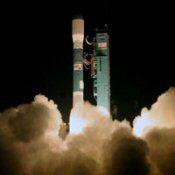
Credit: Boeing/Thom
Baur
|
Satellites
launched for Weather, Climate, Air Quality Studies
Information adapted from
JPL website. Read full article.
28 April 2006.
NASA
has launched two satellites, CloudSat and Calipso, on missions to study the inner workings
of clouds and aerosols, tiny particles suspended in the air.
Technologies
on board the satellites will enable scientists to study how clouds
and aerosols form, evolve and interact. Clouds
play an important role in the Earth's climate, but are still poorly
understood. CloudSat and Calipso
results in a major step forward for studies of the global atmosphere.
Scientists expect that these missions will lead to new insights
into the workings of the planet's climate and improve their abilities
to forecast weather and predict climate change.
The satellites
will fly in formation as members of NASA's "A-Train" constellation,
which also includes NASA's Aqua and Aura satellites and a French satellite
known as Parasol.
|
________________________________________________________________________________________
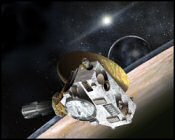
Artist impression.
JHUAPL/SwRI
|
New Horizon Project: the Pluto probe after 100 days in space...
Information adapted from New Horizons Homepage. Read
full article.
1 May 2006.
In all respects, the probe is still doing fine. The New Horizons probe
going to Pluto passed its 100th day in space (another 10 years to
go though!)
April
saw the probe crossing the orbit of Mars, speeding away at over
75,000 kilometers an hour. Most of the activities so far centered
on instrument checkouts, e.g. the SWAP solar wind detector, which
opened its launch door on 13 March 2006 and successfully turned
on its detectors later in the month.
|
________________________________________________________________________________________
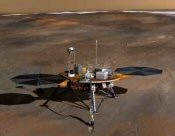
Artist impression.
Credit: NASA
|
Ongoing preparation
of NASA's
2007 mission to Mars
Information obtained from Universe Today. Full
Article. 2 May 2006.
The next mission to the
surface of Mars will take the form of NASA's Phoenix Mars Lander. It is now beginning a new phase
as part
of launch preparations. Launch is scheduled for August 2007.
The plan
is to land Phoenix near Mars's north polar ice cap to analyze samples
of icy soil. Scientists know that there is frozen water in the surface
layers of Mars at high latitudes. Phoenix is designed to provide more
clues about the region as a possible habitat for life.
|
2. Astronomy news from around
the world
|
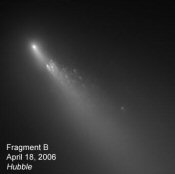 Fragment B of the Comet. credit:
NASA, ESA, H. Weaver (JHU/APL), M. Mutchler
and Z. Levay (STScI)
Fragment B of the Comet. credit:
NASA, ESA, H. Weaver (JHU/APL), M. Mutchler
and Z. Levay (STScI)
|
73P/Schwassmann-Wachmann 3 captured by
Hubble provided
astronomers with spectacular detail of comet 73P/S-W 3's breakup.
The comet is busy disintegrating as it nears the Sun - additional
fragments have been detected by Hubble, not reported by Earth-based
telescopes.
The observations
provide a grand opportunity to study the break-up of a comet nucleus,
which is the porous and fragile mixes of dust and ice making up
the body of the comet. The comet is already a long chain of over
three dozen fragments, stretched over a distance several times the
angular separation of the Moon.
Even amateur astronomers are busy
studying the comet. On 17 May the comet will make its closest approach
to the Earth and there is a possibility that it will be visible to
the naked eye. You can currently see the comet in the constellation
of Hercules - see section 5 below for more information.
|
3. Interesting Space Facts
|
The following are terms used to convey distances in
space:
Astronomical
Unit (A.U.) - The average distance from the Earth to the Sun,
approximately 150 million km.
Parsec - The distance at which a star would have a parallax
of one arc second with a baseline of 1 AU (the mean Sun-Earth distance).
A parsec is equal to 3.2616 light years or 206,265 astronomical
units (AU).
Light Year - The distance travelled by light in one year
= 19 500 billion km (63,240 AU).
Comets are a type of asteroid orbiting the Sun, but they
usually do so in a highly elliptical orbit. As they near the Sun,
they start shedding dust, gas and other icy debris (they are "melting"
in essence) - that is the "tail" of the comet that you see. In other
words, when comets are too far from the Sun, they don't have any
tail. Comets mainly come from the Kuiperbelt and Oort Cloud
- a vast area at the outer extremes of the solar system.
Some comets orbit the Sun once every few years, others once
every thousands of years. Some comets get bright
enough to be seen by the naked eye or with a binocular. Comet movement, brightness and size can be monitored by amateur
observers.
The first recorded comet observation in South Africa was
made in 1652 (December) by Jan van Riebeeck. Governor Simon van
der Stel made the first recorded observation of Halley's comet on
8 September 1682. (Sky Guide Africa South 2006)
|
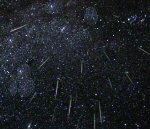
|
What causes
a "meteor shower"
As comets approach the Sun, they start to disintegrate and throw of
gas, dust and other icy debris. The comet leaves a path of this debris
behind and when the Earth crosses the path, it moves "into" the comet's
leftover particles. The particles then enter the atmosphere of the
Earth, appearing to "radiate" from a specific area in the sky. During
times when the Earth crosses a comet's debris field, increased meteor
activity can be seen: sometimes numerous meteors (also known as "shooting
stars") can be counted in an hour. The photo at left was exposed over
a few minutes and shows the apparent radiant of a meteor shower, with
the meteors "streaming" from it.
See section 5 below for information on the Eta Aquarids meteor shower
of May 4-7.
|
___________________________________________________________________________________________
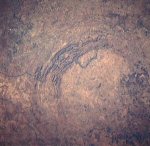
Satellite photo
of the Vredefort hills - NASA
|
Where
on Earth is the biggest and oldest visible impact structure created
by a meteorite?
The world's largest meteorite crater is called the Vredefort dome
- located near the towns of Vredefort and Parys in the Free State, South Africa.
The Vredefort Crater was always believed to be of volcanic origin,
but studies deemed it a meteorite crater of 300 km wide, made by a
10 km sized rock which hit the Earth some 2.1 billion years ago. (The
area is already too eroded to easily distinguish it as a meteorite
crater.) This meteorite may have had an enormous impact on the history
of life on Earth. It was also responsible for "lifting up" sediments
containing gold deposits - the gold mines are neatly situated on the
rim of the structure.
More information at www.hartrao.ac.za/other/vredefort/vredefort.html.
See also Google
Earth
image.
|
__________________________________________________________________________________________
On the lighter side...

|
Is it true that comets bring omens of bad luck and can even
change the colour of your eyes if you stare at it for too long?
Well, there were reports in the past of people complaining
of stomach problems and said that their dogs began to incoherently babble in
some language resembling an ancient Chinese dialect. They were Californians however, so you can't be sure.
Your eyes changing colour? Perhaps if you stare at the comet AND paint
your eyes purple at the same time - yes, then it will change colour.
If comets freak you out, rather think of them as cute little fuzzy
bunnies with big smiles on their faces.
|
Planets visible - early May
Mercury is moving into Aries. It is a morning object, but is
fast disappearing into the glare of the Sun. It will emerge as an
evening object at the end of the month.
Venus is visible in the mornings, shining brightly in the constellation
of Pisces (it's impossible to miss Venus!)
Earth is currently not too far from the Moon. It's somewhere
between the orbits of Venus and Mars and should come around every
24 hours or so. If you look up and don't see it - don't worry. It's
down there somewhere.
Mars is visible as an evening object, in the constellation
of Gemini. It shines with its typical red tinge.
Jupiter is visible the whole night, rising late afternoon in
the east, in the constellation of Libra.
Saturn is visible in the constellation of the Crab (Cancer),
in the evenings.
Constellations and stars
Your "zenith"
is the fixed point directly above your head - 90 degrees above the
horizon. The "meridian" is the north-south line running through your
zenith, also fixed. Around the
middle of the month, on or near the meridian at 21h00 are the constellations
of: Musca, Crux, Centaurus, Hydra, Corvus & Crater, Virgo, Coma
Berenices, Canes Venatici.
Other events
Full
moon on 13 May 2006. New moon on 27 May 2006.
Eta Aquarids meteor shower peaks on 5 May 2006 - in the morning.
It is suggested that you go outside between 4h00 and 5h00 and look
towards the constellation of Aquarius. In the past, between 20 and
30 meteors have been seen per hour from Bloemfontein. The shower should
still have activity after May 5, sometimes outbursts can occur after
the peak.
Comet 73P/Schwassmann-Wachmann 3 is currently located in Hercules, brightness magnitude
7.5, visible with binoculars. A practical time to look is at or around
midnight - Hercules lies straight north above the horizon between
1h00 and 2h00.
Detailed finder chart at www.heavens-above.com
- type in your city and proceed to the observation page. Follow comet
link.
Mei maand Sterrekyk
Die Sterrekyk rubriek vir Mei 2006, geskryf deur Auke Slotegraaf,
met meer inligting oor die sterre, planete en konstellasies (en 'n
paar ander stories!) is nou beskikbaar en kan gelees word by http://assa.saao.ac.za/html/sterrekyk_2006_mei.html
|
6. Amateur Astronomers'
Corner
|
|
Suffering from Severe Telescope Disorder (STD)?
It too often happens that people spend thousands of Rands
on a commercial telescope and rarely using it thereafter. It then
quickly becomes nothing but a second-hand classified ad, or an ornamental
piece of furniture. Why is this so?
Some of the reasons can be 1) an insufficient understanding of the
telescope's workings, 2) too high expectations created beforehand,
3) the telescope becoming more of a hassle to operate than anything
else and 4) probably the biggest reason: shortage of TIME.
What to do about these problems?
1) A telescope doesn't have a mind of its own. Even if it is
highly automated, you will still have to go through many hours of
experimentation and practice. You must learn the workings and tricks
of your telescope, sometimes hour after painstaking hour.
2) Rushing in to buy a telescope is big no-no. Study up on
the types of telescopes beforehand, do research on the internet, read
books, look through a fellow amateur astronomer's telescope and make
peace with the fact that you will never own the Hubble.
3) Make it easy and user-friendly. It is essential to make
the whole experience of transportation and use as comfortable as possible.
Build a little wagon to transport it on, set aside an area in the
garden, even build a tiny shed with a roll-off cover. Make it ready
to roll!
4) Make time. If you are unsure whether you will have time
to use the telescope, think twice before investing in something expensive.
It will only depress the living electrons out of you if you walk by
your telescope each day and it screams "I WANT TO GO OUTSIDE!!"
Remember that you can also build your own telescope -
much cheaper than buying. It takes a lot of time during the first
try, but can be a very rewarding and fulfilling experience. Some become
so good, that their self-built telescopes rival the quality of comparative
commercial instruments! If you are from the Bloemfontein area, contact ASSA Bloem if you are interested,
otherwise, contact your nearest ASSA Centre. Also remember ScopeX in Johannesburg on 6 May 2006.
|
7. Astronomy & Science
in Southern Africa
|
|
|
Astronomy
at UNISA and the UNISA Observatory
UNISA has various courses in astronomy.
The UNISA observatory is situated on the main campus in Pretoria and
is a modern, well-equipped facility housing a 14 inch telescope. The
observatory is used to train astronomy students.
Website: http://astro.unisa.ac.za/~uniobs/
|
__________________________________________________________________________________________
For other SA Astronomy websites, go to
the SpaceTides SA Astronomy Portal at:
www.assabfn.co.za/spacetides/sa_astronomy.htm
8. Astronomy Events in the
City of Bloemfontein
|
The different astronomy organisations
in the City, working hand-in-hand to inform people about the
fascinating world of astronomy and spaceflight,
can be reached as follows:
Boyden Observatory: www.uovs.ac.za/boyden
One of the most publicly accessible observatories of its kind
on the continent, also housing SA's third largest telescope.
To arrange group visits to the Observatory, phone Dawie van Jaarsveldt
at +27 +51 - 401 2561.
Special Boyden open-evening
on Sunday, 7 May 2006: the world-famous astrophotographer
David Malin from Australia will appear at Boyden Observatory near
Bloemfontein and present "Images of Science". 18h00.
Not to be missed. R25 per person. Bookings ESSENTIAL - phone 051-401
2322.
Boyden open-evening on Saturday
evening, 20 May 2006: do you want to know how it is to live
in space? Have you ever thought of becoming an astronaut? Learn
more about space exploration and decide for yourself whether you
should have rather become an astronaut... Bookings open one
week prior to event and is essential: phone 051-401 2322. R30 per
vehicle. 18h00. Great friends & family outing.
__________________________________________________________________________________________
|
|
A public interest
group for Boyden Observatory and for people interested in joining
the astronomical community of Bloemfontein, but not necessarily make astronomy their hobby. Contact
Braam van Zyl at 051-436 7555 (h). Anyone can become a member.
News: The website of
the Friends of Boyden has had a major overhaul: special "Explore Boyden"
section now available.
__________________________________________________________________________________________
|
Affiliated with
the Astronomical Society of Southern Africa, the Bloemfontein Centre
of ASSA is an active organisation of amateur astronomers meeting
on a regular basis to discuss and practice astronomy as hobby. Activities
include solar-, lunar-, deep sky- and comet & meteor observations,
as well as historical research, telescope building, tours and away-weekends
under dark skies. Send an e-mail to mail@assabfn.co.za or visit the website.
|
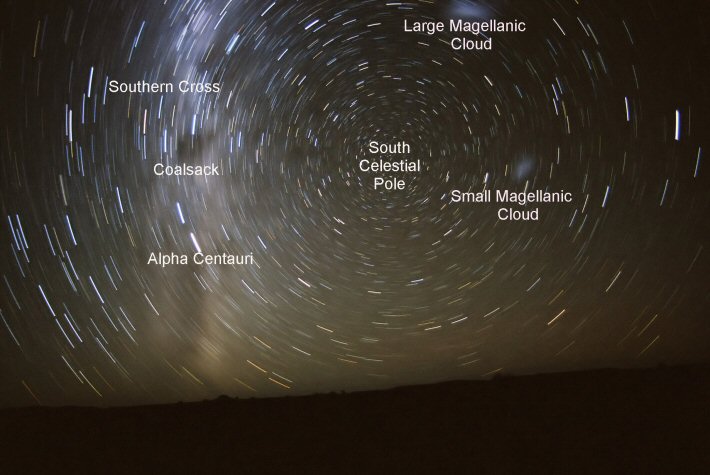
Beautiful image of star trails
near the Crux region of the southern skies. The south celestial pole
is in the centre - it clearly displays the circumpolar motion of the
stars as the night progresses. Objects like the Coal Sack nebula and
the Large and Small Magellanic clouds are easily visible. Photo taken
in March 2006 by Ferdi Prins, during a visit to Sutherland in the
Northern Cape. Equipment used: Pentax K1000 film camera and Fujifilm 200 ASA.
|
SpaceTides
is a free internet e-zine for persons interested in expanding their general
knowledge of astronomy and spaceflight.
The e-zine originates from the City of Bloemfontein in South Africa and
is compiled us a service to the public by ASSA Bloemfontein Centre
as part of their educational outreach activities. Website: www.assabfn.co.za.
SpaceTides contains links to various other third party sites on the internet, not always connected to SpaceTides.
The persons and entities responsible
for compiling SpaceTides will not be held responsible for the content
or information on these third party sites or any damage of any kind
incurred from
downloading, opening, or viewing anything from/through these sites.
If you would like to unsubscribe from SpaceTides, send an
e-mail to spacetides@assabfn.co.za
with the word "Unsubscribe" in the subject line.
|



